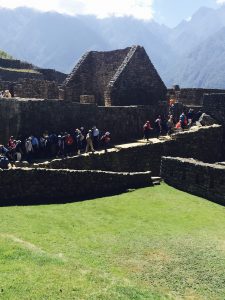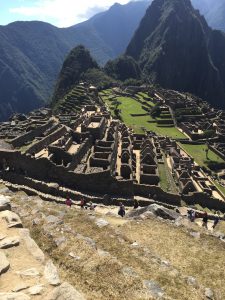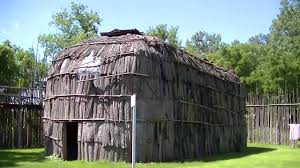Today’s post comes from Isa Pengskul, class of 2019 and Art Center Student Docent
“Okay, so I’ve set aside an hour and now I’m prepared to experience everything on display in the museum.” This is the deluded thought (I hate to admit) I sometimes have when I visit other medium sized galleries
Category Archives: Site Feed
People are Beautiful opening lecture, “Reel to Real: Andy Warhol’s World”
Today’s post comes from Delphine Douglas, class of 2018 and Art Center Multimedia Student Assistant
On Friday, January 26, the Frances Lehman Loeb Art Center hosted a lecture and reception to celebrate the opening of the new exhibition, People are Beautiful: Prints, Photographs, and Films by Andy Warhol. Vincent Fremont delivered the opening lecture, titled “Reel to Real: Andy Warhol’s World,” in Taylor Hall 102
On an Opal Gospel Panel
Today’s post comes from Olivia Feltus, class of 2021 and Art Center Docent.
On October 26th, 2017, poets and curators came together for a panel talk in exploration of Robert Rauschenberg’s Opal Gospel (1971) in which he used Native American texts to create a series of translucent prints
What to do with Machu Picchu? A Class Debate
The site of Machu Picchu is undoubtedly a crucial source of cultural and economic capital for Peru’s civilians and leaders. Still, the exact cultural patrimony of the site remains under debate, namely between the indigenous peoples of Peru, Peruvian government and criollos, Peru’s tourism industry, National Geographic, and Yale University.
Hiram Bingham III, who eventually received funding from both Yale and National Geographic, is often credited with the discovery of the Incan site. However, indigenous farmers had already been aware of Machu Picchu. The precedence that Yale and National Geographic have been given with the site has more often than not surpassed that of any other group, especially the indigenous descendants of those who have once occupied the site. As such, and as was argued in the class debate, Yale’s relationship with Machu Picchu is sullied with imperialist ideology. It is easy to see why there would be a reluctance to work with Yale as well as National Geographic in the present day repatriation of the objects.

Inner architecture of the citadel. Note the triangular stone working- probably meant to honor the spirits that take the form of mountains (Lubow).
The fact that the 5,000 Machu Picchu artifacts that Yale possesses are loans from Peru that have never been returned further justifies the incredulity there is in the negotiations regarding repatriation. If Yale’s return of the artifacts is conditional and there is no apology given for not returning the artifacts, then it can easily be argued that Yale is undermining the capacity of the country’s intellectuals and academics. If funding is an issue, then past perpetrators should be more than willing to place those who have been exploited at the forefront of further research and attainment of the discussed cultural patrimony, specifically in the jobs that they would like. This wasn’t presented in the debate until we neared the end. It is easy to feel that what we believe to be in the best interest of others is correct. It is certainly much easier than seeking the opinion of those who will live its consequences.
Economic, academic, and cultural goals can often come into conflict with each other. However, in class, Peru’s tourist industry was especially at odds with the rest of these interest groups. Unlike everyone else, tourism leaders in Peru want to increase the influx of tourists into Machu Picchu. Or will they be understood to be just as dynamic as the people who visit? Physical deterioration of the site is also something that needs to be taken into account. One suggestion was to use technology to create digital tours of Machu Picchu. Another was to move museums and cultural centers away from Machu Picchu, or sectioning off areas that were not accessible, thus filtering the influx of visitors to the actual site. Even if physical deterioration were to be minimized, there would undoubtedly be increased exposure to ancient and modern Peruvian culture. The manner of exposure would possibly be detrimental to the physical condition of the site. The cultural importance of the site as well as respect towards the inhabitants of the area will vary depending on the way that tourists are exposed to the site. Will the indigenous people in the area be seen as part of the scenery and as a group of uncivilized others who have been lost in time?
It is important to humanize the indigenous peoples of Peru. Not even the Peruvian government can be necessarily trusted to do this, as it is dominated by those of Criollo descent and education, again minimizing indigenous participation. Perhaps this humanization would entail decreasing the romanticization of Machu Picchu and the people of the area. It might be begin to be remediated by the government, through increasing access to education and increasing measures to decrease poverty among indigenous peoples. Still, in class, it was argued that one of the issues with removing the mythical attributes of the site would be decreased interest in tourism, and thus decreased revenue and exposure. In part, this is true. One possible way to cultivate respectful interest would be again, to let indigenous people be at the forefront of telling their stories, in whichever way they’d like. There is mysticality in the unknown, and the intricacies of of other cultures are rarely made known to members of other cultures.
Each of these interest groups can be a part of making Machu Picchu an area for learning and furthering of knowledge of the past. The 5,000 object that are in contestation must be repatriated, and indigenous people must be at the forefront of it. Still, the long term goals of acquisition of knowledge and economic sustainment through tourism. The objects should be repatriated without conditions. The most advancement is most likely to occur when other countries are willing to offer assistance rather than imposition when dealing with cultural patrimony.
The Overuse of Resources by Modern Society
Throughout history humans have used resources from their environment to aid in their survival and to grow as a species. As humanity has grown, so has the demand of resources. But as time has gone on, our resource use has grown less and less sustainable. According to Smith (2010), Gro Harlem Bruand said, “Sustainable development is development that meets the needs of the present without compromising the ability of future generations to meet their own needs.” Humans used to always respect the environment, and knew to give back to it in order to sustain both themselves and the environment they were a part of. Populations would simply scatter and become nomadic if a city fell apart. But now, such ideas have all but disappeared as humanity is destroying the planet we live on as our demand of resources reaches critical levels.
In some ways, ancient civilizations were very similar to our own. They contained societal hierarchies that were similar to our own. They created permanent settlements that grew in number. But ancient civilizations were also very different from modern civilizations. They lacked the technology we posses. Their ideals and religion differed from ours as well. But most importantly, they were moderately sustainable. People back then had to rely on their environment a lot more than we do today. They relied on their environment to give them what they needed to survive. If their was a bad drought and the crops died, then there was no food for the city. Nowadays, farmers can simply pump water up from the ground to irrigate their crops, or get the water delivered to them from somewhere else. They also spray pesticides and chemicals to improve the crop yield. They contaminate their environment to survive. Ancient civilizations used the materials around them to build their homes and produce goods. Modern civilizations burrow into the ground and send and receive goods from around the world.

Modern society gains many of its resources through mining and related activities. This can destroy and destabilize the land around it as well as contaminate nearby water tables.
We overproduce goods to gain a higher profit while not realizing that in doing so we are overusing our resources to the breaking point. Some groups like the Native Americans valued the land and thought it belonged to no one. Now we have become obsessed with gaining land and resources to use for ourselves rather than the entire group. According to Smith (2010) “Private property laws ensure the continuing organization of space, even after physical destruction”. But ancient civilizations were not perfect. Eventually they too overused their resources and eventually collapsed. However, our civilization has reached that phase faster than most others before us. we have managed to reach the phase that took the Maya more than 500 years to reach in less than half the time. If we want our civilization to continue, we must eventually learn to be just as sustainable as those ancient civilizations were.
Sources:
http://wideurbanworld.blogspot.com/2011/02/were-ancient-cities-sustainable.html
Additional Resources:
https://www.ncbi.nlm.nih.gov/pmc/articles/PMC3327537/
http://uvamagazine.org/articles/the_trouble_with_civilization


